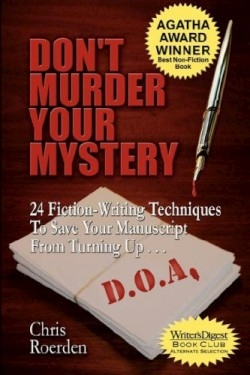It looks like you've stumbled upon a page meant to be read by our code instead of viewed directly. You're probably looking for this page.
Don't Murder Your Mystery
24 Fiction-Writing Techniques to Save Your Manuscript From Turning up D.O.A.
- 2006 INDIES Finalist
- Finalist, Reference (Adult Nonfiction)
For every author whose manuscript gets published, there are tens of thousands who are rejected. At literary agencies and publishing houses, screeners go through piles of submissions, searching for original voices, attention-grabbing characters, and writing styles that rise above the rest. The piles are large; time is short. The writer who has labored a year or more on a story may have only a page, a paragraph, or a sentence read before the screener moves on to the next submission. It is this heartbreaking reality that the author (who is also an editor and writing teacher) addresses in this helpful book.
Pitched midway between the writing advice books that concentrate on format and grammar and those that outline the large-bone mystery basics such as plot, character, dialogue, and creating suspense, Don’t Murder Your Mystery identifies twenty-four aspects of the mystery novel, some dealing with the nitty-gritty of submissions but most discussing topics to help inexperienced writers improve the quality of their written work. Roerden’s pitch is to help new writers identify and correct pedestrian mistakes and avoid amateurish writing, so they won’t be quickly dismissed by screeners. What she has created is an essential handbook for writers longing to improve their knowledge of craft and technique.
One of this volume’s greatest strengths is that it grows out of a large body of experience. Unlike the writer who writes one book, then publishes a “how-to” book, evidently believing that writing is a “see one, do one, teach one” profession, Roerden writes from forty years in the trenches. She has taught writing at the University of Southern Maine and the University of Wisconsin-Milwaukee. She has published nine other books, including four ghostwritten for clients. As a writing coach, she has helped many writers improve their manuscripts. She knows what causes dull, flabby, or amateurish writing, and she knows how to fix it.
Roerden has a clear and thoughtful style with multiple examples from published authors illustrating how to write it right and contrasting examples of how writers get it wrong. In her chapter on the importance of “hooks” to grab a reader from line one, she offers this flabby and awkward version of an opening:
I was lazily watching my tall, well-built body guard mowing the lush green lawn in her bright pink bikini when I heard a loudly buzzing small, private airplane flying overhead. When I looked up, I saw the scary sight of a man’s body falling from the sky.
Roerden then contrasts this with the actual opening of Charlaine Harris’s Dead Over Heels:
My bodyguard was mowing the yard wearing her pink bikini when the dead man fell from the sky.
If writers will read Roerden’s book and absorb the lessons, the world will be a better place for readers. She addresses irritations such as the “data dump,” contrasting it with carefully chosen and telling detail, tired old conventions like the detective staring into a mirror, the unknowing and tiresome use of clichés, jumpy point-of-view, screwy time-lines, and missing transitions. She provides solid advice on integrating setting into story and listening as a way of learning to write dialogue. She reminds the writer not to have characters named Jackie, Ritchie, Teddy, Megan, Marilyn and Margaret in the same story. To bring attention and originality to gesture so that a book isn’t full of women perpetually tossing their heads. Each point is made with detailed explanations and supported by examples. Chapters end with succinct summaries of major points.
Some readers may find the structure used to organize the book, a peculiar mixture of medical and investigative technique, off-putting. There’s also a tendency toward puns, as the author defines a leading cause of a manuscript’s slow death as “adverbosity and adjectivitis.” Skip those parts if they bother you, they don’t affect the substance of her book.
Don’t Murder Your Mystery is smarter, more comprehensive, more effectively targeted, and more accessible than most books on writing. While it is designed for the beginning mystery writer, it should not be overlooked by mainstream writers or authors with experience. Roerden’s clues, especially those later in the book on cliché and gesture, on learning to show, not tell, and on style, language, and resonance, offer a thoughtful tune-up for writers at all levels.
Reviewed by
Kate Flora
Disclosure: This article is not an endorsement, but a review. The publisher of this book provided free copies of the book to have their book reviewed by a professional reviewer. No fee was paid by the publisher for this review. Foreword Reviews only recommends books that we love. Foreword Magazine, Inc. is disclosing this in accordance with the Federal Trade Commission’s 16 CFR, Part 255.
